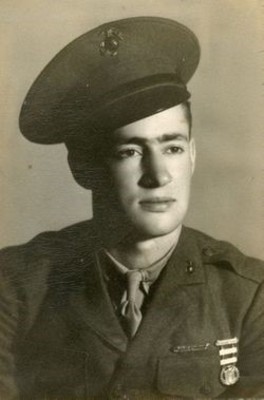Pfc John T Burke
The Defense POW/MIA Accounting Agency (DPAA) announced today that Marine Corps Reserve Pfc. John T. Burke, 18, of Newton, North Carolina, killed during World War II, was accounted for on May 15, 2019.
(This identification was initially published May 28, 2019.)
In November 1943, Burke was a member of Company B, 1st Battalion, 8th Marine Regiment, 2nd Marine Division, which landed against stiff Japanese resistance on the small island of Betio in the Tarawa Atoll of the Gilbert Islands, in an attempt to secure the island. Over several days of intense fighting at Tarawa, approximately 1,000 Marines and Sailors were killed and more than 2,000 were wounded, while the Japanese were virtually annihilated. Burke reportedly died on the second day of the battle, Nov. 21, 1943.
Despite the heavy casualties suffered by U.S. forces, military success in the battle of Tarawa was a huge victory for the U.S. military because the Gilbert Islands provided the U.S. Pacific Fleet a platform from which to launch assaults on the Marshall and Caroline Islands to advance their Central Pacific Campaign against Japan.
In the immediate aftermath of the fighting on Tarawa, U.S. service members who died in the battle were buried in a number of battlefield cemeteries on the island. The 604th Quartermaster Graves Registration Company conducted remains recovery operations on Betio between 1946 and 1947, but Burke’s remains were not identified. All of the remains found on Tarawa were sent to the Schofield Barracks Central Identification Laboratory for identification in 1947. By 1949, the remains that had not been identified were interred as unknowns in the National Memorial Cemetery of the Pacific (NMCP), known as the Punchbowl, in Honolulu, including one set, designated as Tarawa Unknown X-98.
On Jan. 23, 2017, DPAA disinterred Tarawa Unknown X-98 from the NMCP for identification.
To identify Burke’s remains, scientists from DPAA used anthropological and chest radiograph comparison analysis. Additionally, scientists from the Armed Forces Medical Examiner System used mitochondrial DNA (mtDNA) analysis.
(This identification was initially published May 28, 2019.)
In November 1943, Burke was a member of Company B, 1st Battalion, 8th Marine Regiment, 2nd Marine Division, which landed against stiff Japanese resistance on the small island of Betio in the Tarawa Atoll of the Gilbert Islands, in an attempt to secure the island. Over several days of intense fighting at Tarawa, approximately 1,000 Marines and Sailors were killed and more than 2,000 were wounded, while the Japanese were virtually annihilated. Burke reportedly died on the second day of the battle, Nov. 21, 1943.
Despite the heavy casualties suffered by U.S. forces, military success in the battle of Tarawa was a huge victory for the U.S. military because the Gilbert Islands provided the U.S. Pacific Fleet a platform from which to launch assaults on the Marshall and Caroline Islands to advance their Central Pacific Campaign against Japan.
In the immediate aftermath of the fighting on Tarawa, U.S. service members who died in the battle were buried in a number of battlefield cemeteries on the island. The 604th Quartermaster Graves Registration Company conducted remains recovery operations on Betio between 1946 and 1947, but Burke’s remains were not identified. All of the remains found on Tarawa were sent to the Schofield Barracks Central Identification Laboratory for identification in 1947. By 1949, the remains that had not been identified were interred as unknowns in the National Memorial Cemetery of the Pacific (NMCP), known as the Punchbowl, in Honolulu, including one set, designated as Tarawa Unknown X-98.
On Jan. 23, 2017, DPAA disinterred Tarawa Unknown X-98 from the NMCP for identification.
To identify Burke’s remains, scientists from DPAA used anthropological and chest radiograph comparison analysis. Additionally, scientists from the Armed Forces Medical Examiner System used mitochondrial DNA (mtDNA) analysis.
